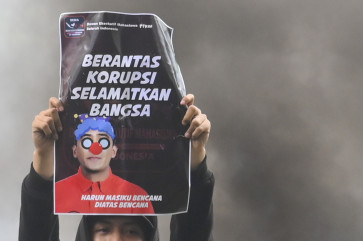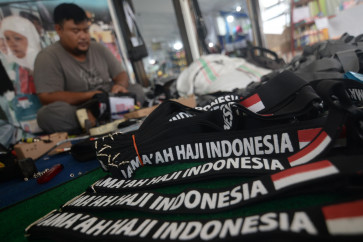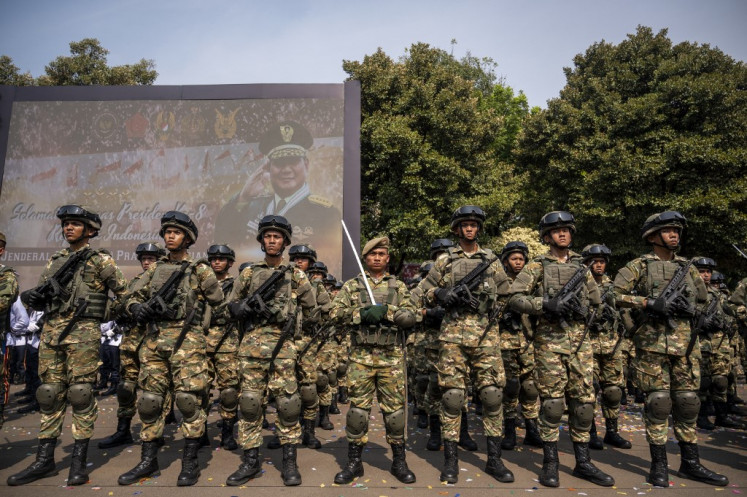An ocean sewn with islands – and shipwrecks
Only a handful of Indonesia’s museums focus specifically on maritime heritage.
Change text size
Gift Premium Articles
to Anyone

I
ndonesia is more sea than soil. As a nation, it is better understood – to paraphrase Indonesian maritime historian Adrian Lapian – as an ocean sprinkled with islands than as land separated by water. Within its seas, bays and rivers lie the remains of hundreds, if not thousands, of shipwrecks. These ancient relics provide historical evidence that supports President Joko “Jokowi” Widodo’s push for Indonesia to reclaim its role as a proud maritime nation.
Despite the abundance of shipwrecks in its waters, however, the Indonesian government’s approach to managing and protecting these sites can best be described as equivocal. For over 20 years, the commercial salvage of shipwrecks in Indonesian territorial waters was legal, until new heritage legislation prompted a temporary, and then a permanent, moratorium on these activities.
But in recent months, through the introduction of the Job Creation Law and associated regulations, the Indonesian government has again reversed course when it comes to managing the wrecks in its waters. This has left many observers to wonder about the future of the archipelago’s maritime history and heritage.
Indonesia introduced its first legislation relating to shipwrecks in 1989. It had been prompted to do so following the salvage a few years earlier of the Geldermalsen, an 18th century Dutch shipwreck found in waters near the Lingga archipelago south of Singapore. The Geldermalsen case revealed the vacuum that existed in Indonesia in relation to shipwrecks in its territorial waters.
The recovery and sale of the Geldermalsen’s cargo, including gold ingots and around 150,000 pieces of porcelain, had raised over 10 million pounds (US$13.6 million) – none of which went to Indonesia. In response, Indonesia introduced a Presidential Decree No. 43/1989 that established a National Shipwreck Committee to approve and issue shipwreck salvage permits to commercial operators. This decree marked the beginning of Indonesia’s commercial shipwreck salvage policy.
This policy continued to evolve over the next two decades. To salvage a wreck, a company had to first apply for a survey permit. This involved extensive bureaucratic wrangling as well as numerous fees. Then, if the survey identified a site of interest, they could apply for a salvage permit. The company was responsible for all costs associated with the survey and salvage process.
Foreign salvors could be involved in surveying, salvaging and utilising valuable objects, but were required to partner with an Indonesian company. Profits from the realized commercial value of the objects had to be shared between the salvage company and the Indonesian government.
Numerous shipwrecks were recovered under this commercial shipwreck salvage policy. Among the most famous of these is the Belitung (Tang) shipwreck, a 9th century Arabian-style stitched-hull vessel recovered in waters off Belitung Island with a full cargo load of Tang dynasty ceramics. Over two salvage seasons in 1998 and 1999, approximately 60,000 objects were recovered. Following conservation, the assemblage was sold to Singapore for an astonishing $32 million, with many of the objects now on permanent display at the Asian Civilisations Museum.
Less famous, but arguably of greater significance to Indonesia’s early maritime histories, was the 10th century Intan. This wreck was commercially salvaged in 1997 and, unlike the Belitung, retained by Indonesia. The Intan remains the oldest Southeast Asian (as distinct from an Arabian-style or Chinese) wreck to be found with a complete cargo.
The era of commercial shipwreck salvage in Indonesia came to an end with the introduction of a new Heritage Law No. 11/2010. Since that time, Indonesia has had a moratorium on commercial shipwreck salvage, made permanent through Presidential Regulation 44/2016. However, the situation has again changed with the introduction of the Job Creation Law No. 11/2020, which seeks to facilitate business, reduce bureaucracy and boost investment.
New regulations associated with the Job Creation Law have been coming into effect over the last few months. One of these is Presidential Regulation No. 10/2021, which effectively overturns the permanent moratorium and reopens shipwreck salvage to commercial investment. Commercial exploitation is explicitly banned by the 2001 UNESCO Convention on the Protection of the Underwater Cultural Heritage, but, as it is not a signatory, Indonesia is not obliged to abide by these principles.
These changes have come through the Office of Coordinating Minister for Maritime Affairs and Investment. The ministries usually charged with managing shipwrecks and maritime heritage – the Maritime Affairs and Fisheries Ministry and the Education and Culture Ministry – must now navigate the complex new laws and draft additional technical regulations in order for commercial surveying and salvaging activities to re-commence. In doing so, they will need to consider how to enforce archaeological standards and involve local maritime archaeologists.
It is understood that officials are considering how to restrict the sale of salvaged objects such that they cannot leave the country. This points to a rising heritage nationalism in Indonesia and suggests a greater willingness to recognise shipwrecks with foreign origins or cargo as essential considerations in conceptualising Indonesian maritime history.
Officials are also considering new ways to recoup survey and salvage costs incurred by commercial operators. Rather than allowing the sale of the objects to private collectors or foreign museums, the idea is that the costs will be recouped through local museum ticket sales and associated maritime heritage tourism activities, such as shipwreck trails. But these costs are not insignificant.
Globally, museums tend to display no more than 3 percent of their entire collection at any one time. By this logic, for every three shipwreck objects on display another 97 will need to be stored and cared for.
This approach is commendable for its focus on a more sustainable rather than extractive approach to managing objects recovered from Indonesia’s waters. But it is based on the flawed assumption that museums are profitable entities with the capacity to generate sufficient profit to cover such costs.
Only a handful of Indonesia’s museums focus specifically on maritime heritage, and of these, few – such as the Samudra Raksa Museum and the East Belitung Maritime Gallery – are located outside the capital Jakarta. More commonly, regional museums have an orientation to maritime culture without actually being maritime heritage museums. To generate profit, let alone enough to cover the costs of salvaging, conserving and displaying shipwreck artefacts, significantly more investment in these museums will be needed.
Indonesia’s geostrategic location at the crossroads of the Indian Ocean and the South China Sea positions it as one of the world’s great maritime nations. There is no doubting the richness and diversity of the archipelago’s past. But there is, as yet, no strategic and cohesive approach to telling these stories.
Indonesia is already a great maritime nation; its citizens, and its underwater cultural heritage, deserve a sustainable and strategic approach to telling its maritime histories. Rather than looking to the heritage in its waters to generate profit, the Indonesian government would be better off using the Job Creation Law to boost investment in its maritime archaeology and museum sectors.
Failing to do so runs the risk of these stories being lost forever.
***
The writer is curriculum coordinator at the Sydney Southeast Asia Centre, the University of Sydney, with research focusing on the protection, management and interpretation of underwater cultural heritage in Indonesia.









